The 6 Best Plastic Cutting Boards, According to Our Experts
Dotdash Meredith and Yahoo Inc. may earn commission or revenue on some items through the links below.
Protect your knives and your countertops with these dishwasher-safe picks
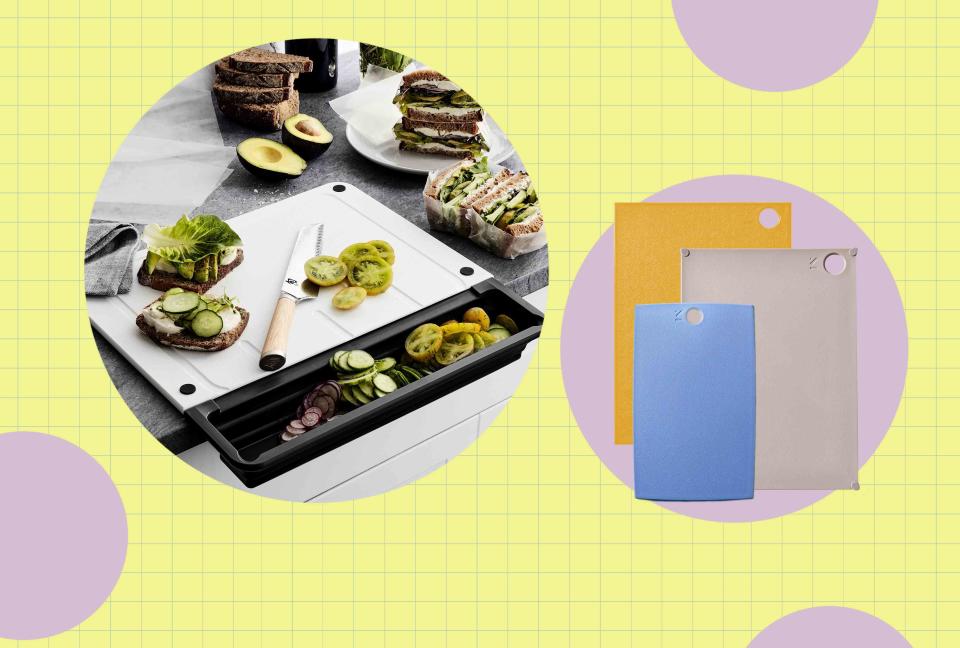
Courtesy of Brand
Though seldom chosen as an essential tool, the lowly cutting board may be the unsung hero of your kitchen. Cutting boards tackle the cuts, the juices, the stains and the odors of your daily kitchen tasks. Preparing any meal without them would result in gouged countertops and dull knives. They’re also a key feature in food safety; finding a cutting board you can sanitize properly to avoid bacteria growth and prevent cross-contamination is essential. While cutting boards are available in many materials, including wood, glass and ceramic, we’ve focused on plastic for its durability, lightweight construction and versatility.
To find the best plastic cutting boards available, we tested 22 models, single boards and sets, over six weeks. We chopped, scored and scrubbed top contenders to see how they held up to the rigors of daily use. Our tests ultimately produced six top options to fit every level of cook and budget—here are our picks.
Our Plastic Cutting Board Recommendations
Best Overall: KitchenAid Classic Plastic Cutting Board
Also Great: Wüsthof TPU Cutting Board, Medium
Best for Small Spaces: Cup Board Pro Synthetic Cutting Board
Best Splurge: Hayate Yoshihiro Hi-Soft High-Performance Professional Grade Cutting Board
Best Set: Gorilla Grip Cutting Board, Set of 3
Best Splurge Set: Material the rePrep Set, Set of 3
Best Overall: KitchenAid Classic Plastic Cutting Board
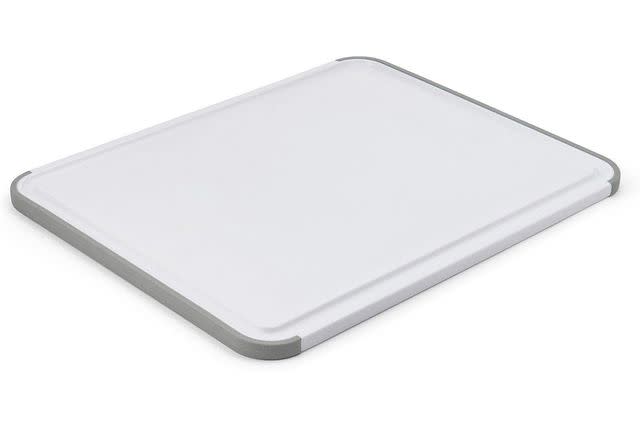
Amazon
What we like: The nonslip edges do a great job stabilizing the board, regardless of which side you use.
What to know: The board showed cut marks quickly after we started using it.
The KitchenAid Classic cutting board is made of polyvinyl plastic in a clean white with gray rubber edges that wrap around to stabilize both sides. The top side features a trench around the perimeter, ideal for catching juices. The board is dishwasher safe and fits nicely in the bottom section of the dishwasher. At a mere 1.9 pounds, the board is easy to move around, even without a handle, and the smooth surface is excellent for scooping ingredients onto your knife for transport to prep bowls.
We found the KitchenAid to be an ideal everyday cutting board. The non-slip feet didn’t budge while we were chopping and slicing, and the two-sided design allowed us to flip the board if we needed to proceed with a task between washings. The size was just right for most uses, although larger cuts of meat would need more room.
Our knives could glide across the board's surface without dulling over time, although we did notice significant cutting grooves that would catch food. The board did not stain, retain odors or warp when run through the dishwasher, and any food in the grooves came out easily.
Materials: Polyvinyl acetate | Dimensions: 13.98”L x 11.02”W x 0.59”H | Dishwasher safe: Yes
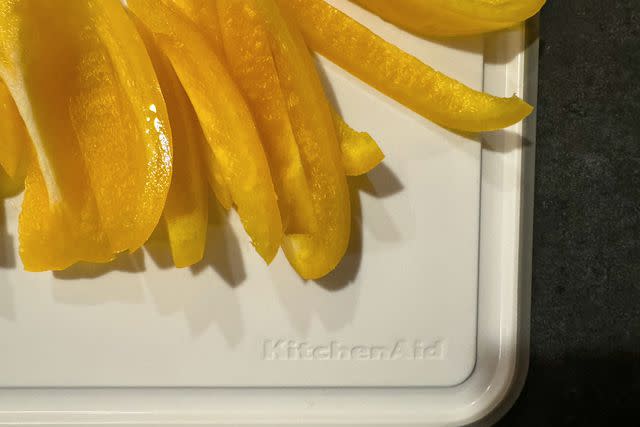
EatingWell / Annie Probst
Also Great: Wüsthof TPU Cutting Board, Medium
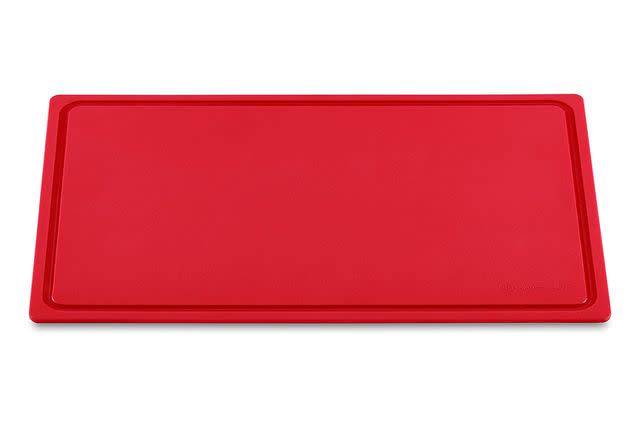
Amazon
What we like: This ultra-light board is flexible, making it easy to maneuver and clean between tasks.
What to know: This board is only available in red and black.
This Wüsthof cutting board is constructed of thermoplastic polyurethane, or TPU, which is a plastic material also found in sporting equipment and electronics. TPU resists abrasion and grease, two excellent properties for a cutting board. The Wusthof board is flexible and lightweight, with a slightly rough texture that grips the countertop to keep the board stable. There is also a groove around the board's perimeter for catching juices.
The weight and flexibility of the Wüsthof made it easy to move through various tasks, and because the board is so thin, it took up very little storage space. When cutting on the board, we found it absorbed our knife strokes without catching or making grooves, and over the testing period, we were delighted to see our knives didn’t dull and the board had no cut marks.
The size of the board allowed it to accommodate everything we cut (with the exception of large cuts of meat), and it fit easily in the bottom section of the dishwasher. It didn’t retain any odors, and the red version of this board did a handy job of masking any potential stains. We did find that having only black and red to choose from was a bit limiting and might not fit into every aesthetic, but overall, this board was a standout.
Materials: Thermoplastic polyurethane | Dimensions: 15"L x 9.8"W x .15"H | Dishwasher safe: Yes
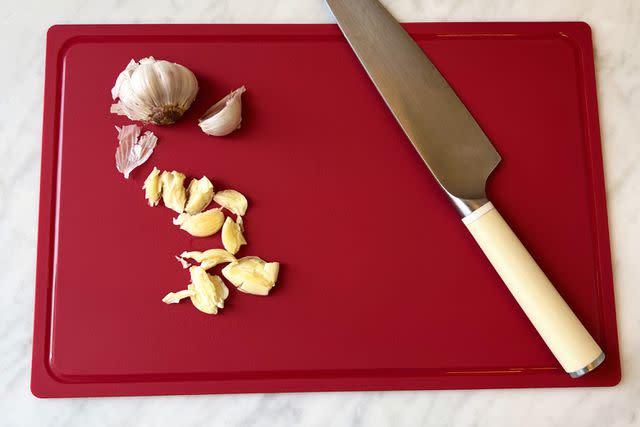
EatingWell / Danielle St. Pierre
Best for Small Spaces: Cup Board Pro Synthetic Cutting Board
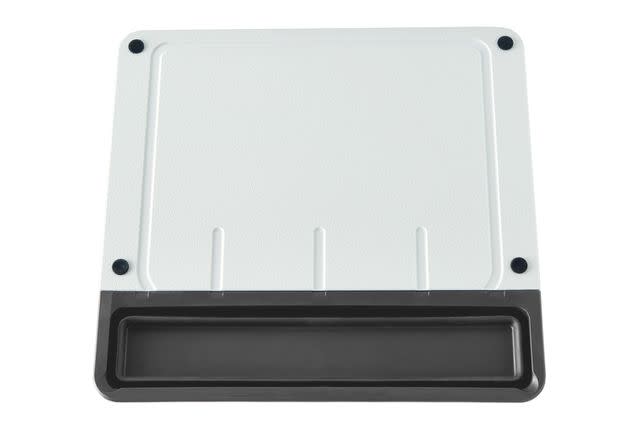
Williams Sonoma
What we like: The removable tray is genius for moving cut items off the board, catching liquids and transferring food to a table or other work surface.
What to know: Cleaning the inset where the tray connects can be tricky.
A “Shark Tank” featured product, the Cup Board Pro is constructed of ultra-durable high-density polyethylene (HDPE), which is prized for its strength-to-density ratio. The dual-sided board features one flat side as well as a side with a channel for catching liquids, plus silicone feet to secure it to the counter. A unique feature is the handy tray that slides out of the channeled side of the board. The tray hangs off the counter’s surface, catching liquids funneled away from the cutting surface and providing a convenient repository for food scraps.
During our testing, the Cup Board Pro was a real revelation. Its cup feature allowed us to catch liquids, keep our surfaces cleaner and make more space for food prep by holding discarded stems and ends. The mildly abrasive surface of the board kept foods from rolling on their own and showed very few knife marks after weeks of repeated use.
Smells and staining materials that came in contact with the board washed away quickly in the dishwasher, and the silicone feet kept the board in place, even on our slippery countertops. The Cup Board Pro’s two-piece design also stores easily in any kitchen. One caveat: While the pop-out tray proved very useful, it was a bit tricky to clean thoroughly.
Materials: High-density polyethylene (HDPE) | Dimensions: 16"W x 11"L x 0.5"H (1”H if including tray) | Dishwasher safe: Yes
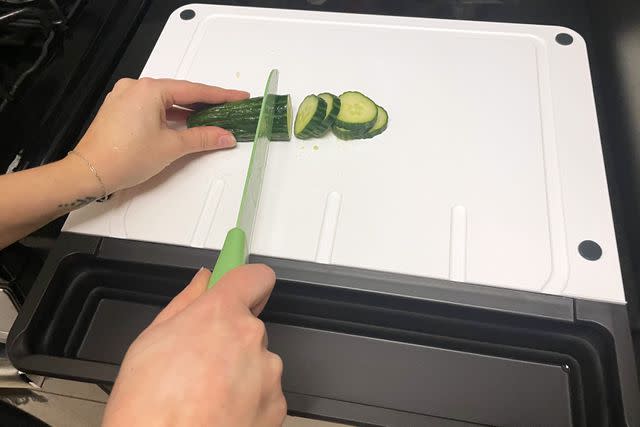
EatingWell / Anna Popp
Best Splurge: Hayate Yoshihiro Hi-Soft High-Performance Professional Grade Cutting Board
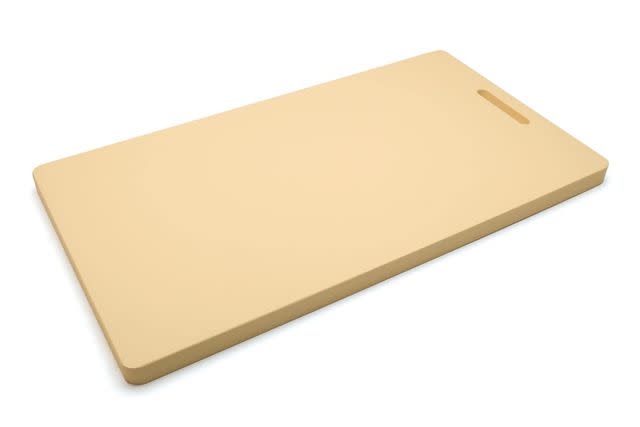
Amazon
What we like: The soft cutting surface felt like it was protecting our knives.
What to know: There is no trench for catching juices, and the board is heavy.
Handcrafted in Japan, the Hayate Yoshihiro is a professional-level cutting board. Constructed of polyvinyl acetate, it is touted to preserve knife edges and relieve hand stress during heavy prepping. One of the larger boards we tested, the Yoshihiro features a smooth surface on both sides and a cutout handle on one end. The board has no “feet” or grips, but the material and weight kept it stable while we were using it.
We loved the feel of cutting on this board; our blade motions were smooth, and the slight softness of the material easily absorbed our knife strokes. The size was excellent for produce and proteins, and the handle cutout served us well when moving this heavy board around the kitchen. It also served as an opening for discarding scraps during prep.
We found that running the board through the dishwasher did not damage it (though the manufacturer recommends cleaning by hand), and although it is quite long, we could handwash it between tasks without issue. The surface didn’t show stains or retain any odors, and though it carried a higher price tag, we found this model so appealing that we wanted one in every size.
Materials: Polyvinyl acetate | Dimensions: 19.6"W x 10.6"L x 0.8"H | Dishwasher safe: No
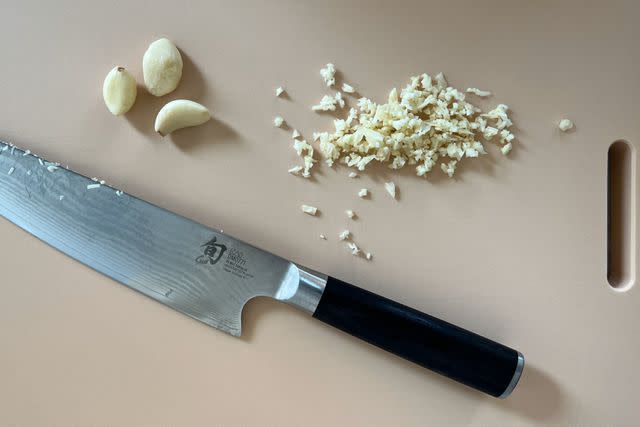
EatingWell / Jennifer Zyman
Best Set: Gorilla Grip Cutting Board, Set of 3
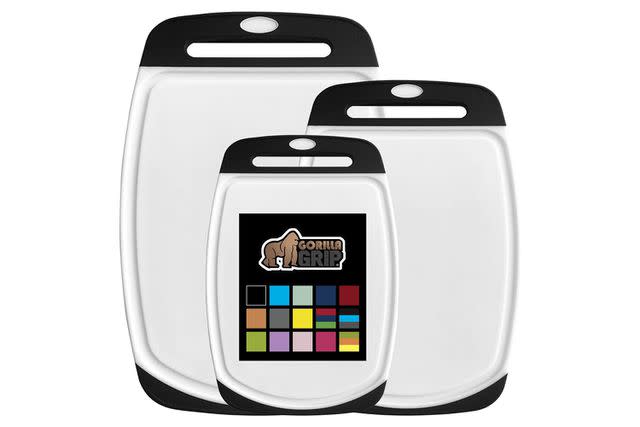
Amazon
What we like: The handles and light weight allowed us to move ingredients directly to our pots and bowls.
What to know: A single, multifunctional board may serve you better if storage space is an issue.
The Gorilla Grip set features three board sizes: a small board ideal for single pieces of fruit and snacks, a medium board for everyday tasks and a larger board that can handle more robust cutting and moderately sized proteins. The boards have a BPA-free rubber grip on each end that wraps around for use on both sides. Each board has a handle and a trench around the perimeter for catching juices. The price of this set is unbeatable as well, breaking down to less than $7 a board.
We liked the range of sizes in this set, which accommodated a variety of kitchen tasks and kept us from cleaning more than needed. The rubber grips didn’t slip or slide at any point in our tests, and the boards came clean without retaining any color or odors, even when we left one dirty overnight. The boards showed minimal cut marks, less than other inexpensive boards we tested, and they didn’t seem to dull our knives. Additionally, the boards come in various colors to coordinate with any decor.
The weight, cost and anti-slip rubber on these boards make them an excellent gift for anyone starting or replacing worn-out boards. The mobility and stability also make this board perfect for seniors or people with smaller kitchens.
Materials: BPA-free plastic | Dimensions: 16”L x 11.2”W x .37”H; 13.8”L x 9.6”W x .37”H; 11.8”L x 8”W x .37”H | Dishwasher safe: Yes
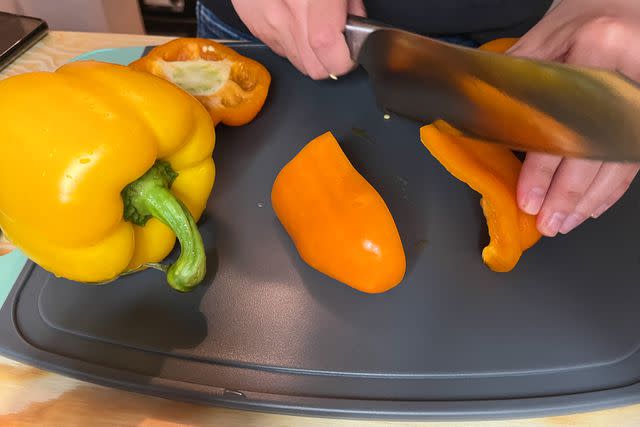
EatingWell / Sarah Felbin
Best Splurge Set: Material the rePrep Set, Set of 3
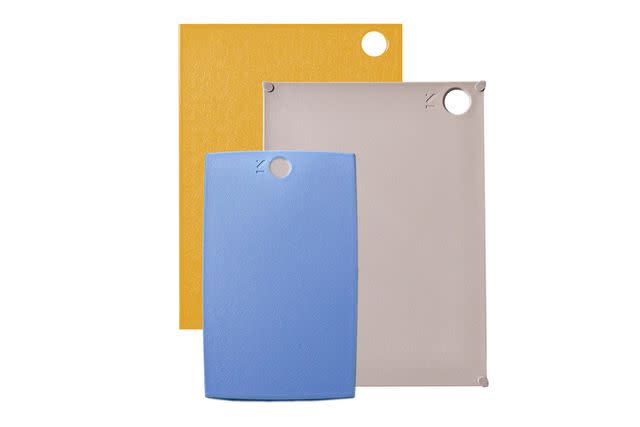
Material Kitchen
What we like: Sustainably-minded chefs take note! Material uses upcycled plastics and sugarcane to construct this set.
What to know: Only one of the boards has silicone feet to grip the counter surface securely.
Known for its thoughtfully designed culinary tools, Material has constructed the rePrep set from recycled kitchen plastics and renewable sugarcane. This modern set features three sizes of boards: the reBoard, the Grippy, and the Mini, and it comes in seven color combinations to fit any aesthetic. All of the boards are ultra-lightweight with a shallow profile and have cut-out handles that make them easy to hang. However, we'll note that, of the three boards, only the Grippy has silicone feet to prevent slipping.
We loved the sleek, modern, lightweight design of these boards and found they made transporting our ingredients from countertop to pan effortless. These boards are dishwasher safe, and they all fit nicely into the bottom rack for cleaning. Or, if you'd rather go the hand-washing route, they'll also fit inside a standard-sized sink.
The boards did show a lot of cut marks quickly, but they didn’t retain any odors or stains. We were a little disappointed in the lack of grip on the reBoard and Mini, and the removable feet on the Grippy, though effective, proved easy to lose. We also would have liked the larger board to have a juice trench. Without it, cutting meats and juicier produce was messy.
Materials: Upcycled kitchen plastic scraps, renewable sugarcane | Dimensions: 14.75”L x 10.75”W x .375”H (reBoard); 14.75”L x 10.75”W x .375”H (Grippy); 13.3”L x 8.5”W x .375”H (Mini) | Dishwasher safe: Yes
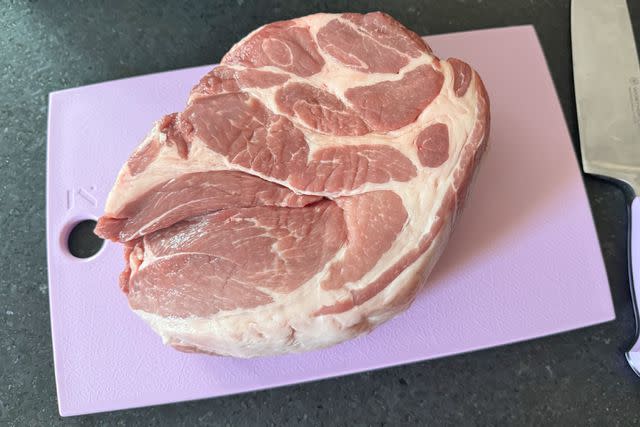
EatingWell / Riddley Schirm
The Bottom Line: The Best Plastic Cutting Boards
Look no further than the KitchenAid Classic Plastic Cutting Board (view at Amazon) for an excellent all-around workhorse. It grips well to the counter, allows smooth-feeling cuts and drops nicely into the dishwasher for clean-up. The dual-sided design gave us a trenched side for juicier items and a flat side if we needed to move without washing the board. If you love high-end gear, the Hayate Yoshihiro Hi-Soft High-Performance Professional Grade Cutting Board (view at Amazon) provides for soft slicing, making prep a joy while protecting the edge of your knives. If you need a variety of sizes (at a price you cannot beat), grab the Gorilla Grip Cutting Board Set (view at Amazon). These boards are easy to clean, they're light and easy to move around the kitchen and they have handy grips and trenches.
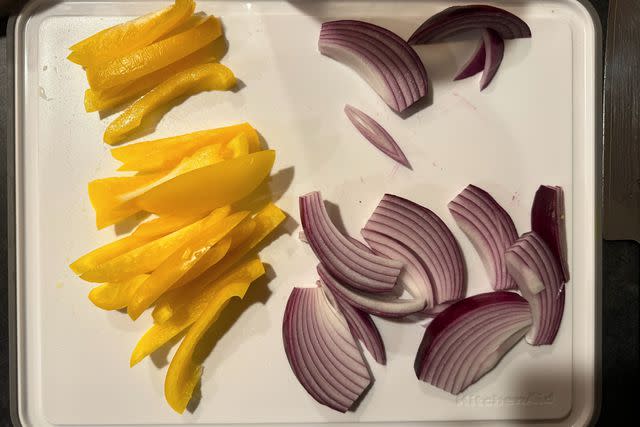
EatingWell / Annie Probst
Choosing a Plastic Cutting Board
Can It Tackle Tough Tasks?
Cutting boards get cut—it’s that simple. So, durability is a top factor in choosing a good one. A board that absorbs knife strokes without sustaining nicks and cut marks will likely wear more slowly, as will a board that doesn’t warp or crack from the high heat of the dishwasher. Cutting boards will likely get dropped frequently and moved around a lot, so finding one that can withstand the “elements” of the kitchen is crucial.
Does It Resist Stains and Odors?
Many different foods will come in contact with your cutting board, and although they should all clean relatively easily, some boards hold onto strong odors and stains—especially from produce like onions or beets. Besides being smelly and unpleasant, having a board that absorbs odors can also be unhealthy. “Absorbent” is not a word you want associated with your board, as absorbed odors can transfer to other foods, making them taste odd or inedible. They can also signal the possible presence of bacteria. And though stains are not a health risk, they can damage the look of your board and make it feel worn before its time. With innumerable materials that resist color and odor issues, you should never settle for one that doesn’t come clean.
Is It the Right Size?
Size factors into many elements of your cutting board decision, from how much the board can accommodate to where it fits on your counters and how it will be cleaned and stored. Knowing your needs will help determine which size (or sizes) are right for your kitchen. Purchasing a board too big to store can cause obvious pain points while having one too small will hinder your prep. Think through your regular usage before choosing your board(s).
Is It Easy to Clean and Sanitize?
Cutting boards are not just cutting surfaces that save your countertops; they also keep your kitchen clean and orderly. A perimeter well for catching juices can save time mopping up meat and produce messes by collecting them for disposal. A dishwasher-safe board that fits in your machine can save cleaning time, though some larger boards or those made of specialized materials may need to be hand-washed. In that case, note the board's weight and maneuverability to ensure you can manage it in the sink.
Our Plastic Cutting Board Tests
We tested each cutting board with daily use over six weeks to get the broadest insights. We evaluated the construction of each board and how the material affected our cutting strokes, the feel of the knife and the amount of visible wear frequent use created.
During our testing, we did not use any stabilizing aids, such as damp paper towels. This allowed us to gauge the board's stability as designed. We tested the feel of cutting on each type of plastic material (yes, they are vastly different), and we checked our knives to see how they were affected. After slicing onions and slippery squid, we sniffed our boards for retained odors, held them up to the light to observe cut marks and gashes and ran them through the dishwasher (if advised) to see if they warped. Finally, we inspected them for stains and noted how easy they were to maneuver and store.
We Also Considered
Henckels Plastic Cutting Board Set, Set of 3 ($35 at Zwilling): We loved this sturdy set with silicone anchors that grip the counter well—but clearly we weren’t the only ones, as this set is currently sold out everywhere. However, we do have some good news: You can still purchase the cutting boards individually (view options at Zwilling).
Joseph Joseph Folio Chopping Boards, Set of 4 ($80 at Amazon): The Joseph Joseph set featured a folio that neatly and attractively contained all four boards, and it was easy to grab them by the handles for use. However, we were concerned with the depth and number of cut marks these boards retained, and we felt they were wearing too quickly.
Misen Plastic Cutting Boards, 2-Piece Set ($39 at Misen): This board set had great gripping feet and offered a good range of sizes for a multitude of tasks. While our knife cuts were barely visible, our knives did stick and squeak against the board’s surface during prep, which we didn't love.
OXO Good Grips Carving & Cutting Board ($33 at Amazon): The OXO performed well with slicing, absorbing our strokes well. The board didn’t have any issues with odors or staining, but the silicone feet seemed a bit undersized for the large board and didn’t stabilize it well. And while the board is dishwasher safe, we found that it was too big to fit inside a standard dishwasher.
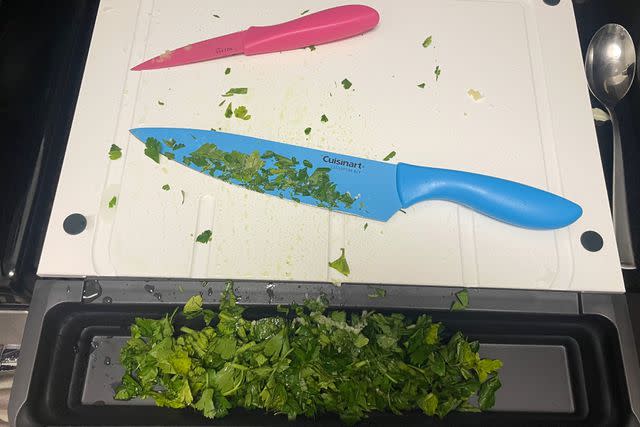
Allrecipes / Anna Popp
Common Questions
Which cutting board is best, wood or plastic?
There is much debate about which cutting boards are the best. When used and cleaned correctly, both plastic and wood cutting boards can resist harboring bacteria and last a long time. The best cutting boards are well-maintained and replaced when needed. Both plastic and wood can sustain nicks and grooves from frequent cutting, and in some cases, boards can break or crack. You will find the best cutting board is the one you can easily maintain.
How do I clean a plastic cutting board?
Most plastic cutting boards are dishwasher safe, so cleaning them is a fairly straightforward process. If your board is hand-wash only, or if it's too large to fit in a dishwasher, wash it well with warm, soapy water and thoroughly rinse it to remove all the detergent. Then, let it dry completely before using it again.
How often should I replace my plastic cutting boards?
Your board's longevity will ultimately depend on its construction and how often you use it. The best time to replace your board is when you notice significant wear. Cutting boards take a lot of abuse, and some show it sooner and more intensely than others. Replacing worn boards is essential for keeping them safe for use and maintaining a sanitary kitchen environment. Nicks and divots can harbor bacteria, and warped boards won’t sit flush with the counter, making them unstable and a potential cutting hazard. Additionally, lots of cuts in the board could deposit microplastics into your food.
Do plastic cutting boards dull knives?
Regardless of your cutting surface, repeated cutting will eventually dull any knife. The hardness of the plastic and lack of forgiveness when cutting play a part in how quickly knife edges wear. Harder surfaces like glass, ceramic, stone and some hardwoods can accelerate the dulling of your knife edges, while softer surfaces like end-grain and softer woods and more forgiving plastics can extend the edge's sharpness. The only way to truly maintain your knife edges is to sharpen them regularly.
Our Trusted Expertise
Tiffany Vickers Davis is a chef, writer and food entrepreneur with over 25 years of experience. Beginning in high-profile restaurant kitchens, she owns and operates a fresh-prepared meal company that ships nationally. Before starting her company, Tiffany was the test kitchen director at Cooking Light magazine, testing hundreds of products from stoves to knives during her 14-year tenure with the brand. She uses wood and plastic boards at home and swears that stability is the most important factor in choosing her boards.
This article was edited by Katie Tuttle, a commerce editor and contributor to publications such as Food & Wine and The Spruce Eats.
Read the original article on Eating Well.

